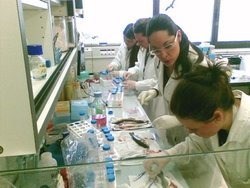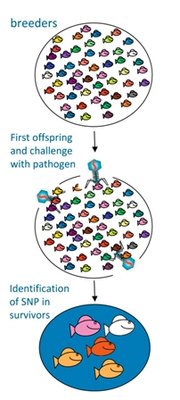 Improved immunity of Gilthead Seabream
Improved immunity of Gilthead Seabream
Entering an era of seabream farming where new technologies are applied to take the most out of its predisposition for domestication.
The aim
The farming of gilthead seabream is going through a stable period, mostly due to its natural resistance to viral infections. Still, its health  status is threatened by several bacterial pathogens (Photobacterium, Vibrio). In addition, gilthead seabream can be an asymptomatic carrier of several viruses which are pathogens for other co-farmed fish. Our IMAQUANIM contribution aimed at characterizing key components of the innate immune response, such as: Isogenic and allelic variability of immune genes to identify the most immunocompetent forms for future selective breeding; TLRs (Toll-like receptors, essential for pathogen recognition); Complement activity in crowded cultured fish; and the kinetics of immune gene expression.
status is threatened by several bacterial pathogens (Photobacterium, Vibrio). In addition, gilthead seabream can be an asymptomatic carrier of several viruses which are pathogens for other co-farmed fish. Our IMAQUANIM contribution aimed at characterizing key components of the innate immune response, such as: Isogenic and allelic variability of immune genes to identify the most immunocompetent forms for future selective breeding; TLRs (Toll-like receptors, essential for pathogen recognition); Complement activity in crowded cultured fish; and the kinetics of immune gene expression.
The outcome
 We have: Cloned several immune genes from pathogen-challenged fish: IF, C3, TLR9, TLR22, soluble and membrane TLR5, LBP/BPI and 3 Mx isoforms; Found evidence for the suppression of both non-specific immune responses and C3 protein expression under stress conditions; Established the main roles for professional phagocytes in recognition and elimination of pathogens and in regulation of adaptive immune responses; Disclosed the role of TLR22 in fish protection against viral infection; Shown that LPS signals via a TLR4- and MyD88-independent manner in fish, and that, surprisingly, the zebrafish TLR4 orthologs negatively regulate the MyD88-dependent signaling pathway; Determined the number of loci and/or the genetic variability for Mx, CD8, IL1-ß, TNF-? from a wild fish population.
We have: Cloned several immune genes from pathogen-challenged fish: IF, C3, TLR9, TLR22, soluble and membrane TLR5, LBP/BPI and 3 Mx isoforms; Found evidence for the suppression of both non-specific immune responses and C3 protein expression under stress conditions; Established the main roles for professional phagocytes in recognition and elimination of pathogens and in regulation of adaptive immune responses; Disclosed the role of TLR22 in fish protection against viral infection; Shown that LPS signals via a TLR4- and MyD88-independent manner in fish, and that, surprisingly, the zebrafish TLR4 orthologs negatively regulate the MyD88-dependent signaling pathway; Determined the number of loci and/or the genetic variability for Mx, CD8, IL1-ß, TNF-? from a wild fish population.
What is next?
We would like to: Assess the functional importance of TLR4, TLR22 and TLR5S and the three Mx isoforms in the seabream immune response using both in vivo and in vitro experimental systems; Evaluate the use of TLR5S as an immunostimulant and adjuvant in fish; Screening a gilthead seabream from wild to disclose advantageous variants (alleles) for the three Mx genes as they exist in a sample from wild gilthead seabream; Complete the characterization of immune responses under stress conditions through developing anti-C3 Ab and assess the cytokine response after pathogen challenging and stress. Develop a microarray to assess the sea bream gene expression after pathogen challenge.